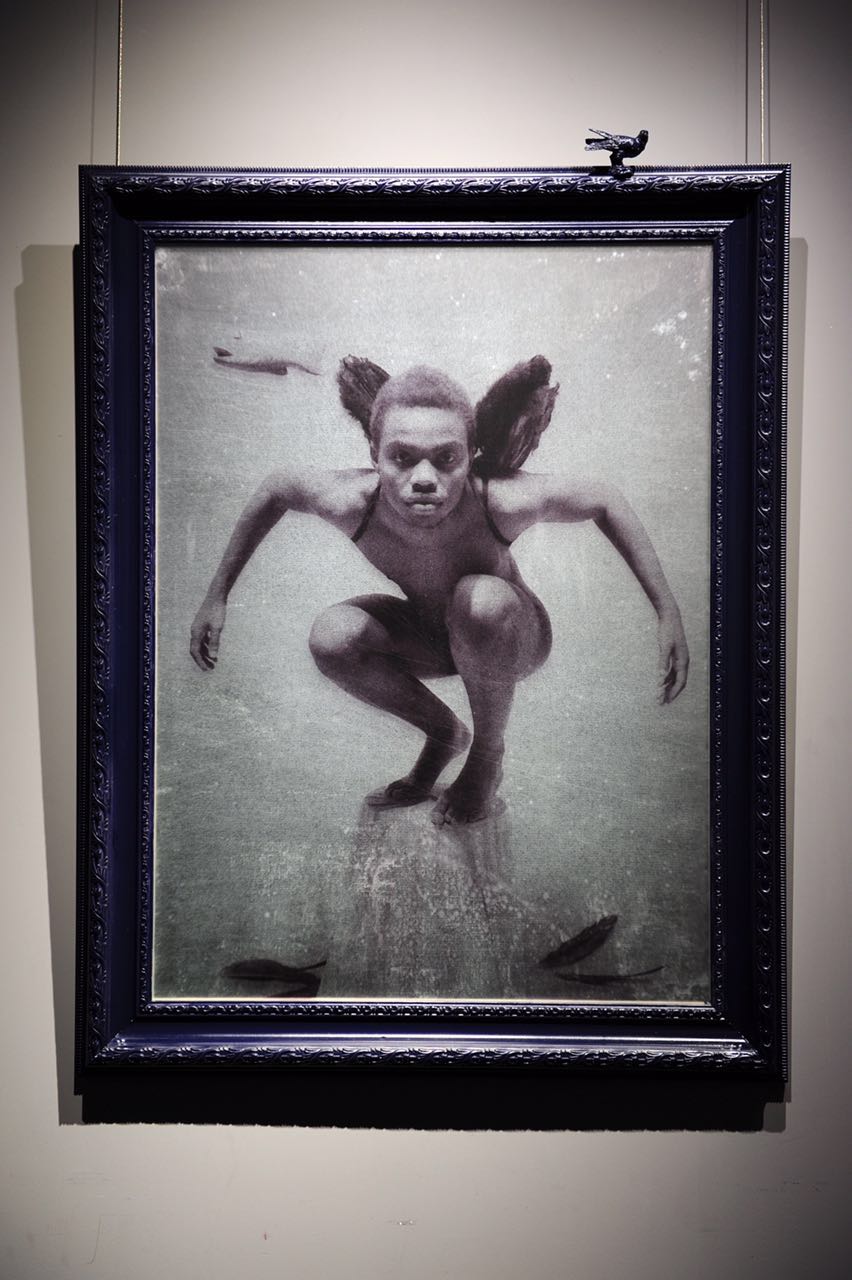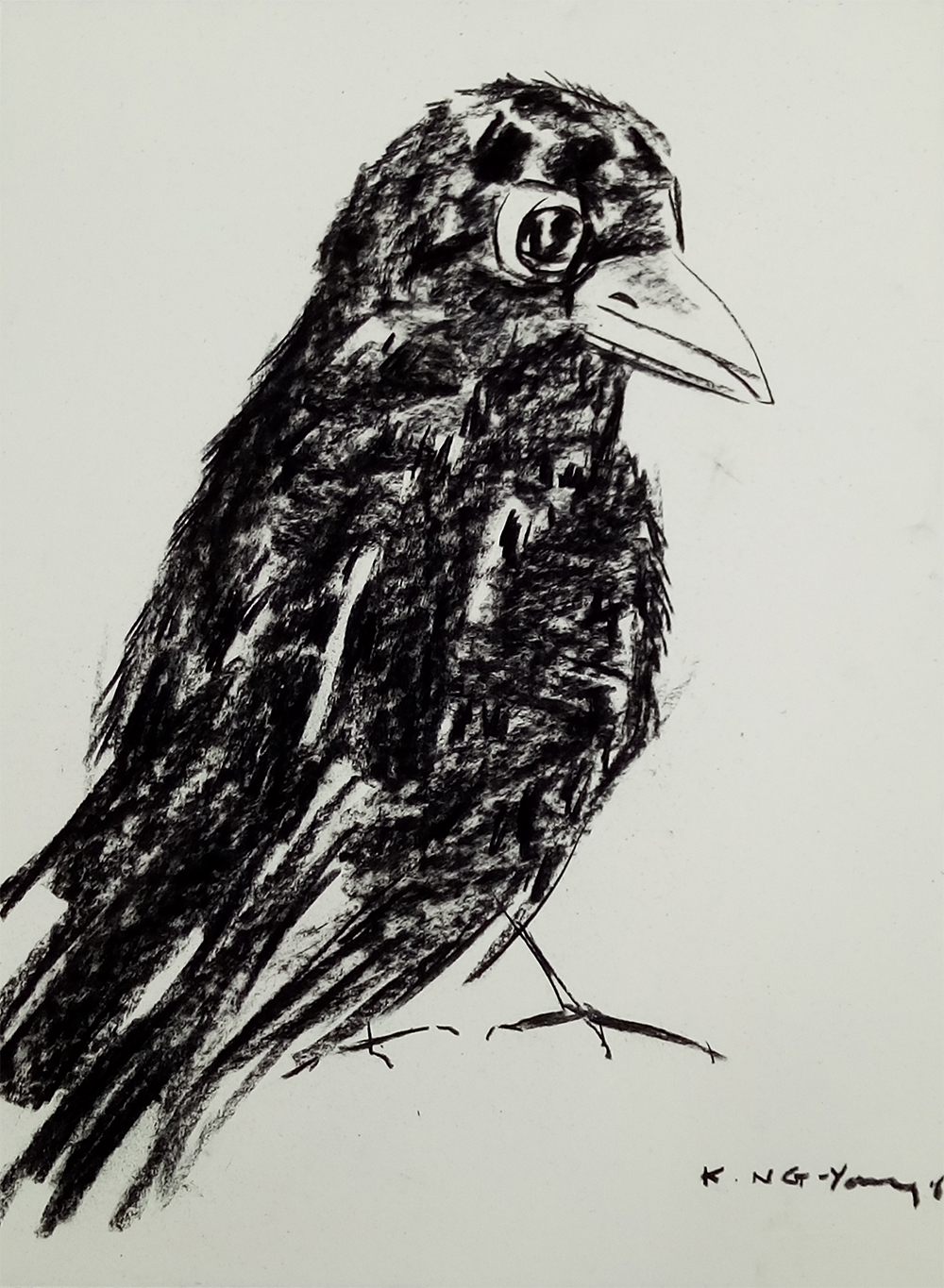2016 “飞鸟与鱼” 杨桦专访 | Interview with Kristin NG-Yang
1. 此次个展的主题为何取名为“飞鸟和鱼”? 所有参展的作品也都是围绕着鸟和鱼而 展开的,这是出于你个人的偏好还是另有缘由?
Why you named this solo exhibition “Fish and Bird”? We noticed all the works were created around the fish and bird, is it for your personal preference or because of some other reasons?
我是比较随性的艺术家。创作的题材大多与我的生活有关,将生活中无意间发现的一些东西作为我作品创作的来源。“鱼”就像我游走在异国他乡;“鸟”有点像近几年来我年年都回国,意寓着像一只候鸟一样。“飞鸟和鱼”这个题材,多少与我个人的生活经历有关系,鸟在天上,鱼在水里,他们是无法相见的。
I’m quite relaxed about my art creation. The inspirations mostly come from my daily life. “Fish” is actually a portrait of myself, describing that I am wandering like a fish outside my motherland. “Bird” is referring to my regular return every year, like a migratory bird. The theme of “Fish and Bird” relates to my personal life experience, bird flies in the sky and fish swims in the water, they are not able to meet each other.

2. 记得两年前你在上海的个展中首次亮相了装置作品”飞鸟和鱼”, 那些悬浮在空中有机玻璃板上印刻着的形态各异的鱼儿在重力和气流的影响下随意飘动着,至今仍让我记忆犹新,印象深刻。两年后的今天,你带来了行为表演“飞鸟和鱼”的影像作品。 请问你是如何想到用这种艺术方式来表达你的创作理念的?
Two years ago, you displayed your installation “Fish and Bird” for the first time during your solo exhibition in Shanghai. I still remember those different shapes of fish printed in ink on the plexiglass in the middle of air. It’s impressive! Today, you bring the video of “Fish and Bird” with live performance, How do you find this way to express your ideas and concepts?
“飞鸟和鱼”是两年前第一次在诺易画廊展出的装置作品,没有任何的附加音乐和表演。后来我回南非后再一次将它挂出来,发现在后面的幕布上有很漂亮的投影,然后我就邀请行为表演艺术家,按照我的想法在幕布上做一些行为表演,在幕布上出现很多很漂亮的投影,这时候我觉得需要音乐来完成这个多媒体影像作品。那应该选择怎样的音乐可以来配合这个影像作品呢?经过很多设想之后,我决定采用中国的古筝和非洲的手鼓。这两个乐器相隔遥远,像飞鸟和鱼一样,是很难相遇的。我请了北京的音乐人王建军按照这个作品想要表达的意图完成了最终的音乐创作。在这之后又添加了行为表演,使之成为一件完整的作品。通常我的作品就是如此一步步走来的,觉得可能是偶然的,但想想也是必然的。
“Fish and Bird” was the first installation exhibited in Noeli Gallery without any additional music and performance. This was my initial idea to present the swimming fish. After I went back to South Africa, I found a beautiful shadow on the curtain when I showed this installation again. So I developed my initial installation into a live art performance. I invited an African dancer to dance like a bird behind the curtain swinging and floating through hundreds of fish and I finally decided to use Chinese Guzheng and African drums as the music of this live performance. These two instruments seem so far away from one to the other, just like bird and fish, it’s difficult to for them to meet each other. I commissioned musician Wang Jianjun from Beijing to create the part of Guzheng based on my concepts. Eventually this live performance video comes to a final complete piece of work.

3. 这次个展的作品表达形式非常多样化,囊括了油画、水彩、镜面摄影装置和影像作品。其中的镜面摄影装置作品是首次进入大家的视线,作品有很强的视觉震撼力,能与我们谈谈这些装置作品的具体创作想法以及在拍摄中是否有独特经历?
We have noticed the diversity of your artworks in this solo exhibition, covering oil painting, watercolor, photographic installation and video works. The photographic installation is the first time to be introduced to the public, they are unique and have a strong visual impact, where does your inspiration come from? Are there any stories you can share with us?
在这之前我没有真正做过摄影作品,这是我第一次展出我的摄影作品。之前有很多朋友会说我拍的照片很有意思,为什么不可以在这方面尝试一下呢?今年做飞鸟和鱼的时候,我希望有新的内容在里面,而摄影这种方式可能在飞鸟和鱼之间表达会更合适。因此我为这位非洲男孩装上了翅膀,并在他周围挂了鱼。这位非洲男孩非常具有表现力,因此他在我整个作品中是极为重要的一个人。因为我在创作的过程中,他也同时在创作。他是一位具有表演天赋的小艺术家。如今他在印度学习艺术,他是目前我所遇到过最好的一位合作表演者。
This is my first series of photographic installation. Lot of my friends found the photos I did were quite interesting, so I said to myself, why not have a try then? As I wanted to develop more with new content in my “Fish and Bird” and I realized photograph might be the appropriate way to convey my idea. So the African boy wears the wings and I hang the fish around him. This African boy is very expressive and talented in acting. He plays a significant role in my work. He is creating his own art alongside mine at the same time. Now he is learning art courses in India and he is the best cooperative performer I’ve ever met.

4. 您的影像作品中结合了非洲的舞蹈,中国古筝以及非洲的传统打击乐,这种跨形式的创作的灵感是来自于何处?
You combine African dance with Chinese Guzheng and African Djembe drum, how does it come across your mind?
我在南非生活了十七年的时间,在这期间,我觉得中国的文化对我来说就如亲生母亲,它是我最基本的东西。非洲的文化与我之间犹如养母的关系。我希望能把这两种不同的文化结合在一起创作出一种新的形式来。“飞鸟和鱼”今年在南非国家艺术节演出的时候,中国人观看之后会觉得当像水墨画,特别是鱼被投影到这个幕布上所呈现出来的画面就像水墨画一样,也有人提到像皮影戏。而当人们听到音乐的时候,很多非洲人觉得非常熟悉但同时又很陌生。因为他们不知道到底古筝是何种乐器?然而有东方文化背景的人对古筝并不陌生,但对非洲鼓会比较陌生。我希望用这两种文化和不同的乐器来共同诠释我的作品。鱼挂起来像水墨画,而表演者的舞蹈非常柔滑,一看就是非洲的舞蹈,让人有即熟悉又陌生的感觉。
I’ve been living in South Africa for more than 17 years. Chinese culture is my root and African culture becomes my second culture, like my foster mother. I always hope to be able to bring these two different cultures together to create something new. When the live performance of “fish and bird” appeared in South Africa’s National Art Festival this year, some Chinese audience considered it rather like ink paintings, when the fish are projected onto the screen; some Chinese considered it more like traditional Chinese Shadow Play. When the music started, many African audience felt very familiar with it, however, there was something unknown and strange about the music. They have no idea about Guzheng and we Chinese are neither close to Djembe Drum. My intention is to merge these two different culture and music to interpret my work as well as to create a sense between familiarity and unfamiliarity.

5. 众所周知,您是一位旅居南非14年之久的中国艺术家,作为一位正在攻读博士学位的移民艺术家,在您的艺术创作过程中,您内心最深切的感受是什么?
As an immigrant artist studying for a PhD in South Africa, what’s your deepest feeling about the process of your art creation?
作为艺术家本身来说,更多的是自己的东西,是非常自我的东西,跟任何人是没有关系的。有时我不知道该用怎样的点去解释,来看我作品观众都有他们自己的理解。在南非的这些年,给了我创作上更多的自由。在南非包括学院里面没有限制,你可以选择任何的创作形式来完成作品。因此我的作品有素描、水彩、油画, 版画等等,形式多样是我创作的特点之一。
As an artist, my creation is very personal and has nothing to do with other people. Sometimes I don’t know how to explain my artworks because each audience has their own interpretation. Over these years living in South Africa, it gives me more freedom in creation. There is no restriction in my university. I can do all kinds of art to create and to complete my works. So my artworks have a wide range of drawing, watercolor, oil painting, engraving, etc., Diversity is one of the characteristics of my creation.

6. 您能用艺术家的身份来谈一谈在中国与南非的不同文化背景下,两国的当代艺术发展有什么共同和区别之处吗?
How do you see the differences of contemporary art development in China and in South Africa?
其实南非和中国都不是走在当代艺术中心的国家,都是在看西方,看美国、看欧洲。这是他们的共同之处。不同的是中国改革开放至今才30多年,教育体系跟西方不同。南非是个英殖民国家,因此他们更早地接受到了西方的东西。当代艺术对他们来说不是什么新鲜的事情。南非也有自己非常优秀的当代艺术家,具有很高的国际知名度,比如威廉·肯特里奇。
Frankly speaking, South Africa and China are both not the center of contemporary art scene world-wide. They are very much influenced by the United States and Europe in terms of contemporary art. This is what China and South Africa have in common. South Africa was once the colony of Britain, so contemporary art is not something new to them. South Africa has their own famous contemporary artists with high international reputation, such as William Kentridge. While China’s open door policy has been only more than 30 years, the development of contemporary art is not as long as South Africa.

